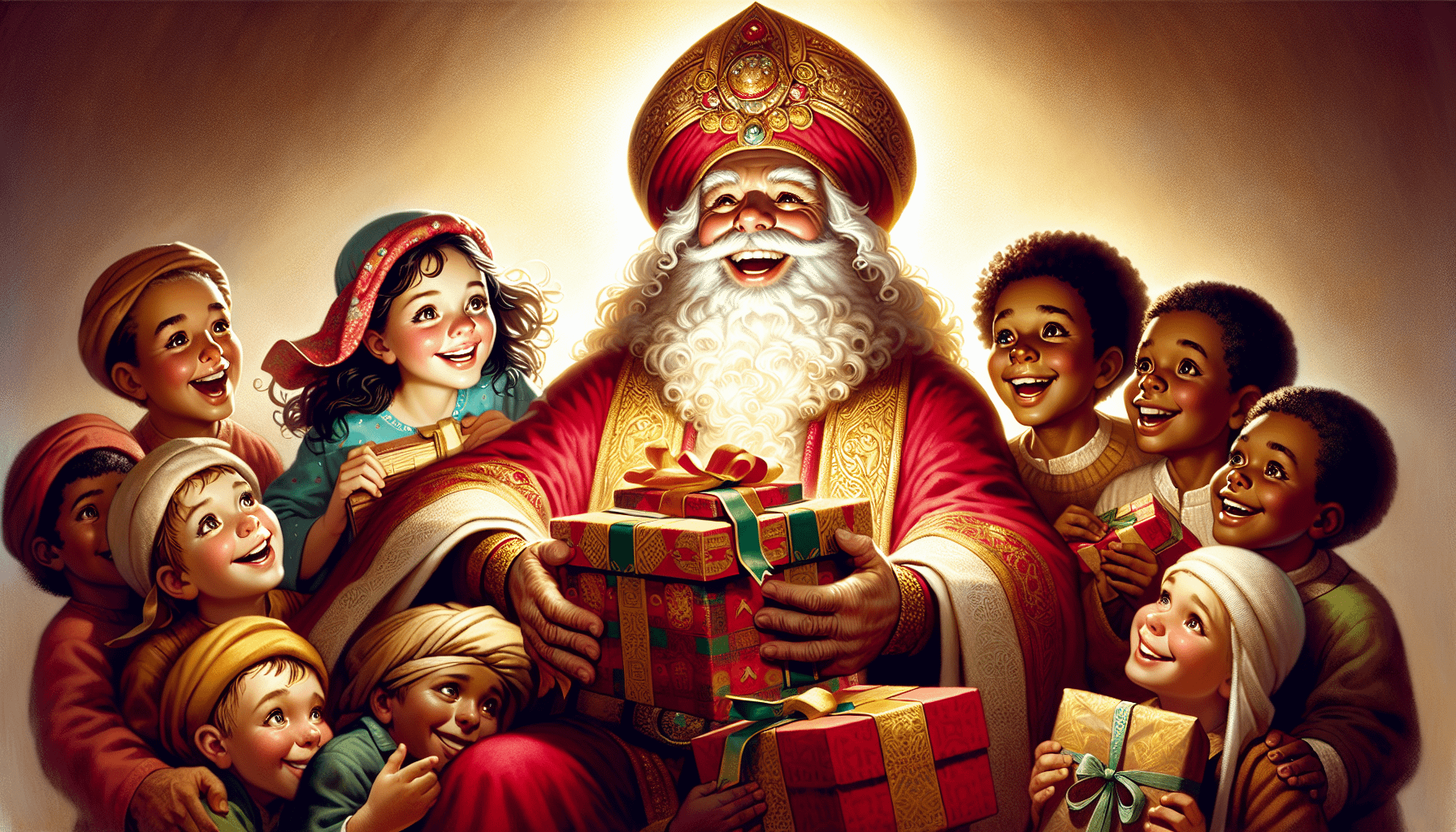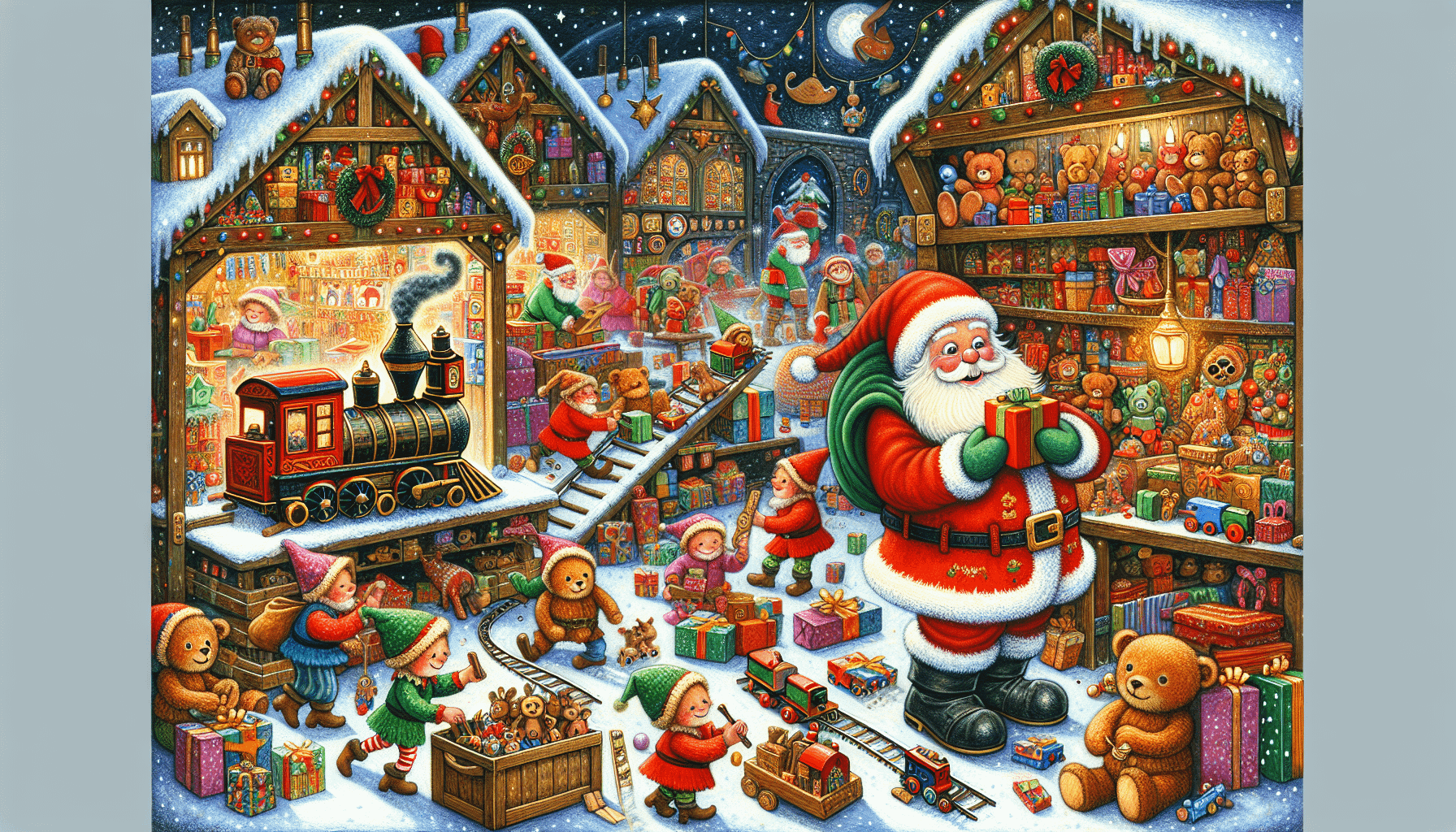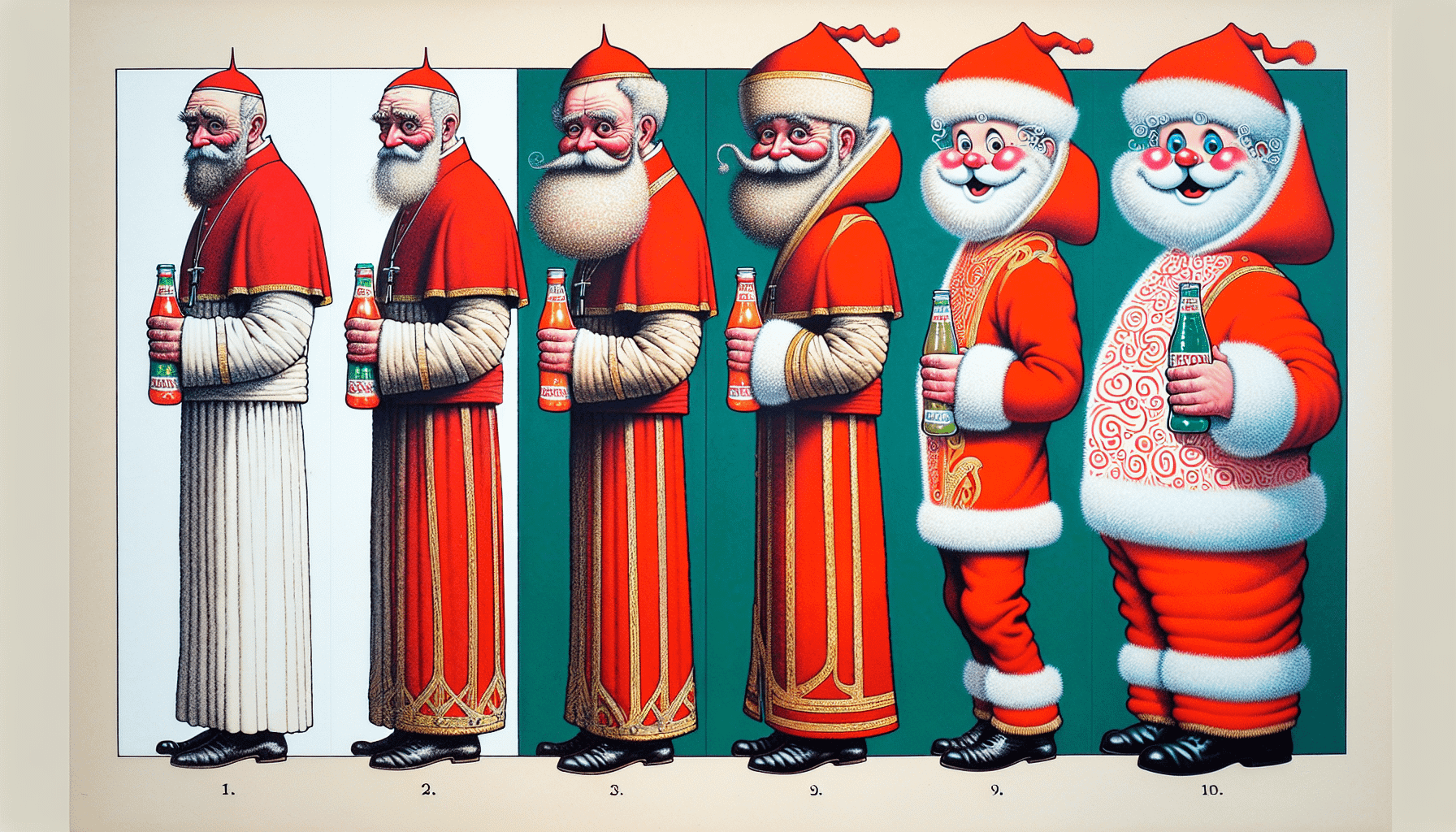Curious about the roots of the jolly man in the red suit and where is Santa Claus from? Santa Claus, a figure synonymous with Christmas cheer, actually hails from a fascinating historical tapestry. Although widely associated with the North Pole, Santa’s true origin story begins with Saint Nicholas, a 4th-century bishop from Myra, now part of modern Turkey. Dive into this article to uncover how ancient traditions and cultural transformations led to the Santa Claus we celebrate today.
Key Takeaways
Santa Claus originates from Saint Nicholas of Myra, a 4th-century Greek bishop, and was shaped by European and particularly Dutch traditions, notably through the transformation of ‘Sinterklaas’ into ‘Santa Claus’ in 19th-century America along with literature such as Washington Irving’s works.
The figure of Santa Claus has been adapted by cultures across the globe, leading to a variety of regional names and traditions; yet he consistently symbolizes joy and generosity and often associated with the North Pole, elevated by the Christmas marketing efforts of companies like Coca-Cola.
Santa Claus’s modern image has evolved through history from a thin bishop or elf to a jolly, rotund figure in a red suit, popularized by cartoonist Thomas Nast and further cemented by Coca-Cola’s advertising, with his legend including iconic elements like a sleigh and reindeer.
The Roots of Santa Claus: From St. Nicholas to Modern Myth

Stepping back into history, we find the origins of Santa Claus in a 4th-century Greek bishop known as Saint Nicholas of Myra. Renowned for his kindness and acts of generosity, Saint Nicholas became a symbol of benevolence, especially towards children and sailors. This ancient saint laid the groundwork for the gift-giving practices in Europe that would eventually evolve into the legend of Santa Claus and our modern Christmas traditions.
But the transformation didn’t stop there. The Dutch influence played a significant role in shaping the Santa Claus we know today. The Dutch name for Saint Nicholas, ‘Sinterklaas’, was Americanized into ‘Santa Claus’ in the 19th century, spreading the figure’s popularity across Europe and the world. This transformation was further amplified by literary contributions, particularly those from American writer Washington Irving, who reshaped Santa’s image into a jolly, pipe-smoking character.
The Patron Saint of Children and Sailors
Saint Nicholas, a Greek bishop from the 4th century, is the earliest known reference to the figure we now call Santa Claus. Revered for his acts of charity, Saint Nicholas earned the title of the patron and protector of children. His benevolence extended to sailors as well, earning him reverence as their patron saint. His acts of kindness, such as gifting dowries to three impoverished sisters, became legendary, setting the stage for the tradition of gift-giving we associate with Santa Claus today.
Children in France even observe a tradition inspired by Saint Nicholas’s feast day on December 6, where they leave out shoes to be filled with treats. These traditions and Saint Nicholas’s reputation for kindness and generosity laid the foundation for the evolution of the Santa Claus we’re familiar with today.
The Dutch Influence and Sinterklaas
Santa Claus’s transformation was greatly influenced by Dutch traditions. The name ‘Santa Claus’ is derived from the Dutch ‘Sinterklaas’, a term that began to evolve in the 17th century and played a significant role in the figure’s transformation. The Dutch portrayed Sinterklaas as:
a tall, slender man with white hair and a beard
dressed in the traditional attire of a bishop
delivering oranges
taking particularly bad children to Spain
This lean and tall Sinterklaas character contrasted sharply with the jolly, rotund figure we know today.
This transformation wasn’t merely physical. The role Sinterklaas played in Dutch households, especially among Dutch families, also evolved, paving the way for the beloved character of Santa Claus. The name ‘Santa Claus’ became popular in America in the 19th century, spreading the figure’s influence beyond Dutch colonies and into the mainstream culture of various European countries.
Washington Irving’s Literary Contributions
Literature played a crucial role in molding the modern image of Santa Claus. American author Washington Irving, in his ‘Knickerbocker’s History of New York’, depicted Saint Nicholas in a humorous light, a stark contrast to the serious and religious depictions that prevailed at the time. Irving’s work transformed the Dutch Saint Nicholas figure into a jolly, pipe-smoking character who delivered presents to children, significantly contributing to the Americanization of Santa Claus. Another key figure in this transformation was Clement Clark Moore, whose famous poem further popularized the modern image of Santa Claus.
Irving’s literary contributions didn’t just alter Santa’s image; they reshaped the way society perceived Santa Claus, transforming him from a saintly figure to a character that embodied the spirit of gift-giving and cheeriness – elements that are integral to our modern Christmas celebrations.
A Global Phenomenon: How Different Cultures Shaped Santa

As the figure of Santa Claus spread across the globe, it began to reflect the cultures and traditions of different regions. In England, he is known as ‘Father Christmas’, while in Spain and South America, he goes by ‘Papá Noel’. In Nordic countries, Santa Claus takes on various names: ‘joulupukki’ in Finland, ‘Julenissen’ in Norway, and ‘Jultomte’ in Sweden, each carrying a unique cultural significance.
This cultural adaptation extends to the Mediterranean as well. Italian children look forward to gifts from ‘Babbo Natale’ and ‘La Befana’ on the Epiphany on January 6. Bulgarian kids wait for ‘Dyado Koleda’ or ‘Grandfather Christmas’, while Greek children receive gifts from ‘Ayios Vassileios’ on New Year’s Eve. This wide array of names and traditions reflects the universal appeal of this jolly figure and his integral role in Christmas celebrations worldwide.
Central Europe’s Christmas Figures
In Central Europe, the figure of Santa Claus takes on different forms. In Germany, he is known as the ‘Weihnachtsmann’, a relatively modern tradition that doesn’t have deep religious or folklore roots. German children write letters to the ‘Christkind’ on Christmas Eve, expecting their letters to be exchanged for presents by the next morning.
This tradition of writing letters to the ‘Christkind’ or Christ Child and receiving Christmas gifts, including a special christmas present, in return is also popular in Austria. These Central European traditions emphasize the excitement and anticipation that lead up to Christmas, capturing the essence of the festive season.
Grandfather Frost and the Eastern Variants
Venturing further east, Santa Claus takes on a different name and persona. In Southeastern Europe, the popular name for Santa Claus is ‘Grandpa’ or ‘Grandfather Frost’. This character is known to bring presents for children during the New Year’s celebrations, embodying the spirit of generosity and joy associated with the holiday season.
Countries such as:
Croatia
Macedonia
Russia
Serbia
Belarus
People around the world celebrate the festive season in various ways, and some even refer to their winter holiday gift-giver as ‘Grandfather Frost’. Despite the geographical distance and cultural differences, the spirit of Santa Claus – a figure of joy, generosity, and holiday cheer – resonates in these traditions, making it a merry Christmas for all.
The Journey to the North Pole: Establishing Santa’s Home Base

As Santa Claus evolved, so did the narrative surrounding his home base. The association of Santa Claus with the North Pole began in the late 19th and early 20th centuries, when children’s publications, Christmas-themed stories, and songs popularized the idea. The North Pole, characterized by year-round snow, became a fitting abode for Santa Claus, aligning with the snowy imagery commonly associated with Christmas.
The North Pole’s allure was further enhanced by the enduring fascination with the Arctic, stemming from 19th-century expeditions that painted it as a mysterious and unexplored region in the public eye. Adding to this suitability was the fact that reindeer, known as Santa’s preferred means of transportation, are native to the Arctic region.
Coca-Cola’s Role in Christmas Marketing
The image of Santa Claus that we know today was also heavily influenced by marketing campaigns. Coca-Cola’s advertising campaigns in the 1930s, in particular, played a pivotal role in defining Santa’s modern image. Illustrator Haddon Sundblom’s work for Coca-Cola transformed Santa Claus into a jolly, warm character with human features.
These depictions of Santa in Coca-Cola’s advertising not only helped to cement the modern image of a cheerful, rotund Santa in a red suit but also associated him with the joy and togetherness that the holiday season embodies.
The Creation of a Christmas Legend
The poem ‘A Visit from St. Nicholas’, also known as ‘The Night Before Christmas’, played a crucial role in shaping the modern American image of Santa Claus, introducing elements like his sleigh and reindeer. The poem also popularized the tradition of children anticipating Santa’s visit on Christmas Eve, with Santa depicted as a cheerful figure who visits homes to distribute gifts.
The identities of Santa’s reindeer, now an integral part of the Santa Claus legend, stem from the 1939 song ‘Rudolph the Red-Nosed Reindeer’. These literary contributions have not only shaped Santa’s image but have also imbued the character with a sense of magic and wonder that continues to captivate children and adults alike.
Santa Claus Today: The Modern Celebration and Representation
In today’s world, Santa Claus’s image is more diverse than ever, with representations in various cultures reflecting their own traditions and ethnicity. From social media profiles sharing messages of cheer and goodwill to inclusive representations with different genders and physical appearances, Santa Claus has evolved to appeal to a broader audience.
Despite these changes, the traditional characteristics of Santa Claus, such as his red suit, reindeer, and role in gift-giving, remain central to his identity across various cultures. He continues to embody the spirit of generosity and joy associated with Christmas, transcending geographical boundaries and cultural differences to bring together people in celebration.
Meet Santa Claus Experiences
A cherished holiday tradition that has stood the test of time is meeting Santa Claus in shopping malls during Christmas shopping. These encounters provide families with a personal and memorable holiday experience, reinforcing the magic of Christmas for children. In fact, it feels like a mini Santa Claus Village right in the heart of the mall.
From sitting on Santa’s lap to whispering their Christmas wishes into his ear, these meet-and-greet experiences create lasting memories for children. The personalized experience of meeting Santa helps to reinforce the magic of Christmas for children, making the holiday season even more special.
Santa in the Adult World
Santa Claus’s influence extends beyond the realm of children’s festivities. By the early 1890s, the Salvation Army utilized individuals dressed as Santa Claus to collect donations for Christmas meals for the needy. This charitable act, in line with Santa Claus’s spirit of generosity, underscored the figure’s relevance in the adult world.
Through this initiative, Santa Claus’s image was used to evoke a sense of compassion and charity during the holiday season. This adult-centric approach to Santa Claus serves as a reminder that the lessons of kindness and generosity that Santa Claus embodies are relevant to all, regardless of age.
Virtual Visits and Technological Advances
As we step into the digital age, interactions with Santa Claus have taken on a new dimension. Virtual visits with Santa Claus have become a part of modern Christmas traditions, allowing for remote engagements with the festive figure. Shriners Hospitals for Children, in partnership with Dimension Data, offers virtual visits with Santa Claus using telehealth technology, enabling children in hospitals to experience the magic of the holiday.
Moreover, technological tools like NORAD’s Santa Tracker have enhanced traditional holiday practices, enabling individuals to:
Follow Santa’s journey on Christmas Eve
Interact with Santa virtually
Experience the magic of Santa Claus in corners of the world that were once unimaginable.
These virtual interactions and technological advancements have allowed the magic of Santa Claus to reach corners of the world that were once unimaginable.
The Evolution of Santa’s Iconic Look

Over the years, Santa Claus’s iconic look has undergone significant changes. Initially depicted as a tall, thin man or an eerie elf, Santa Claus has evolved into the jolly, rotund figure in a red suit that we are familiar with today. This evolution involved transitioning from older, sterner black and white depictions to a more joyful and commercial representation.
Artists like Thomas Nast played a significant role in defining Santa’s image, integrating European traditions with a distinctly American cultural ethos. Nast’s creations, depicting Santa Clausville at the North Pole, laid the groundwork for Santa’s legendary workshop and his status as a joyful gift-giver.
The Quintessential Red Suit
American cartoonist Thomas Nast introduced Santa’s red suit with white fur lining and a buckled black belt in the 1870s. This depiction by Nast became an iconic representation of Santa Claus, and Coca-Cola’s advertising campaigns in the 1930s played a pivotal role in promoting and maintaining this image of Santa with the red and white suit.
The red suit with white fur trimmings became an integral part of Santa’s identity through artists’ renditions and was further solidified by holiday advertisements and popular culture. This quintessential red suit, a signature element of Santa’s identity, has become synonymous with Christmas cheer and the holiday season.
The Sleigh and Reindeer
Santa’s sleigh and reindeer are as integral to his legend as his red suit. The concept of Santa’s sleigh being drawn by eight flying reindeer originates from the vivid depictions in the poem ‘A Visit from St. Nicholas’. This literary contribution popularized the notion of Santa Claus’s magical arrival from the North Pole on a reindeer-drawn sleigh.
The imagery established by this poem has not only influenced the design of Santa’s sleigh and his reindeer but also enhanced the cultural anticipation of his visit on Christmas Eve. Today, the image of Santa’s sleigh soaring across the sky, led by his trusted reindeer, embodies the magic and wonder of Christmas.
Celebrating Christmas with Santa Claus
Santa Claus, with his jolly demeanor and generous spirit, has become a global symbol of Christmas. He embodies the cheer and generosity that are at the heart of the holiday season, bringing joy to children and adults alike. From the early 19th century, gift-giving, with a focus on children, became an integral element of Christmas celebrations, and Santa Claus was at the center of it all.
The tradition of hanging stockings by the fireplace for Santa to fill with presents, which originated in the United States, has spread across the globe, further cementing Santa’s role in Christmas celebrations. Today, families worldwide eagerly await Santa’s visit, filling their homes with joy and anticipation.
Naughty or Nice: A List for Every Child
The tradition of Santa Claus’s ‘naughty or nice’ list is deeply ingrained in popular culture. Parents have used this list as a method to promote good behavior in children, tying their actions throughout the year to the gifts they receive from Santa Claus on Christmas Eve. In this context, naughty children may find themselves receiving fewer or less desirable gifts as a consequence of their behavior.
This tradition not only encourages good behavior but also adds to the excitement of Christmas. The anticipation of being rewarded for being ‘nice’ throughout the year with Christmas presents from Santa Claus creates a sense of excitement for children and contributes to the magical experience of Christmas.
The Night Before Christmas Tradition
On Christmas Eve, families around the world maintain various traditions to celebrate Santa’s impending visit. One such tradition is reading ‘The Night Before Christmas,’ a beloved holiday poem that has helped shape contemporary notions of Santa Claus, including his arrival on Christmas Eve.
Other traditions include hanging personalized stockings on the mantel in anticipation of Santa’s visit and leaving out cookies and milk for Santa Claus as a sign of hospitality. These traditions create a sense of excitement and anticipation, setting the stage for the joyous celebration of Christmas Day.
Summary
In conclusion, the figure of Santa Claus is a tapestry woven with threads of history, culture, and tradition from across the globe. From the ancient Saint Nicholas to the jolly, gift-giving figure we know today, Santa Claus embodies the spirit of generosity, joy, and magic that is at the heart of Christmas. Regardless of the name he goes by or the form he takes, Santa Claus remains a universal symbol of the holiday season, bringing joy and cheer to people of all ages, across all cultures.
Frequently Asked Questions
Where is Santa supposed to be from?
Santa Claus is supposed to be from what is now Turkey, as the historical figure Saint Nicholas of Myra lived and died there.
Is Santa Claus from Finland?
Yes, Santa Claus is from Rovaniemi, Finland, which is the official hometown of Santa Claus and the location of the Santa Claus Village. It has been his home for centuries, and the Arctic Circle is close to his heart because many Christmas secrets are rooted in this magical place.
Who was Saint Nicholas and how did he influence the creation of Santa Claus?
Saint Nicholas, a 4th-century Greek bishop known for his generosity, laid the groundwork for the figure of Santa Claus through his acts of kindness, especially towards children and sailors. This influenced the evolution of Santa Claus traditions.
How did the Dutch influence the transformation of Santa Claus?
The transformation of Santa Claus was significantly influenced by the Dutch, as the name ‘Sinterklaas’ evolved into ‘Santa Claus’ in the 19th century, shaping the figure we know today.
Why is the North Pole considered Santa Claus’s home base?
The North Pole became associated with Santa Claus due to its snowy, wintery imagery, making it a fitting home base for the beloved Christmas figure. This association began in the late 19th and early 20th centuries.



